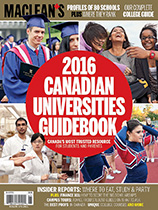New research shows which degrees lead to high-paying jobs
Ross Finnie is collecting information on the job market and human capital. For students especially, it will be a gold mine.
Share

 This story is featured in our 2016 Canadian Universities Guidebook, available on newsstands now. Pick up a copy of the guidebook for full profiles of 80 universities, insider reports written by current students on where to eat, study, and party, and the latest data including the grades needed to get into the school of your dreams and our definitive university rankings.
This story is featured in our 2016 Canadian Universities Guidebook, available on newsstands now. Pick up a copy of the guidebook for full profiles of 80 universities, insider reports written by current students on where to eat, study, and party, and the latest data including the grades needed to get into the school of your dreams and our definitive university rankings.
Information, it’s often said, is power. Yet when high school students are faced with one of the most important decisions of their lives—whether to attend college or university, and which course of study to take, in a sense they’re flying blind. “They’re going on anecdotal information,” says Ross Finnie, a professor in the graduate school of public and international affairs at the University of Ottawa. That’s because there’s very little good data on how students perform in the labour market once they graduate, making it harder to “shop around” for a diploma or degree that will lead to a great job at the end. With a new initiative, Finnie hopes to change that.
Finnie is director of the Education Policy Research Initiative (EPRI) at the U of O, and the leader of an effort to quantify student success with the power of cold, hard data. Starting with students at his Ottawa institution—and recently broadening out to 14 colleges and universities across the country—he’s meticulously tracking each student through school, and years later, using tax data (compiled in partnership with Statistics Canada) to chart how each performs in the job market in the long term. The information is completely blinded, so he and his team don’t know who’s who, and strict security protocols guard everyone’s privacy.
In his latest project, Finnie is tracking virtually every student who graduated from the 14 institutions from 2005 to 2013, the last year of tax data available. That’s half a million young people across the country whose experiences will be captured. (The University of Victoria, the University of Waterloo, Memorial University of Newfoundland, and Hamilton’s Mohawk College are among the schools participating.) The current data-collecting project wraps up this spring, and results will be published sometime after that.
If Finnie’s earlier work is anything to go by, it will be full of valuable and surprising insights. The EPRI’s grad earnings study of 2014, which followed University of Ottawa students, found that social sciences grads start out with average earnings of about $40,000, but reach $80,000 13 years later. Not bad for a degree that’s fallen out of favour with some who think it won’t lead to a high-paying career. “Say I want to study English, and my parents are telling me I’d have to be crazy,” Finnie says. With this type of data, “you could say, ‘Look, English grads don’t make as much as an engineer, but I think that’s enough for me.’ ”
Students aren’t the only ones who benefit. This information is invaluable for policy-makers and institutions, who can tailor their programs accordingly. “The world is constantly changing, and the economy is dynamic,” he says. “Oil and other resources will come and go. What ultimately matters is skills.”
Canada has just one way it tracks students after they graduate. Compiled by Statistics Canada, the National Graduates Survey is voluntary, relies on self-reported data, and was last published in 2013. Akela Peoples of the non-profit Learning Partnership, which supports publicly funded education in Canada, agrees that good data on student outcomes is hard to come by. “What we do have is outdated, and not highly useful,” she says.
British Columbia has its own system of tracking graduates: the Baccalaureate Graduates Survey, done as a partnership between the universities and the provinces, which surveys students two years after they finish. “We learn a lot from it,” says Tony Eder, executive director of academic resource planning at the University of Victoria. “But it’s inexact.” UVic manages to contact about 1,500 graduates each year of the 4,000 who finish school. Finnie’s project at the University of Ottawa, on the other hand, linked 99 per cent of all students up to their tax data, capturing a much more complete picture. With Finnie’s method, “There’s no survey bias, and we get to track over time,” Eder says.
At Mohawk College, Finnie is doing something slightly different. In addition to tracking grads, he’s using predictive models to identify students who may need extra help. Using all sorts of information like age, gender, entering grades, socioeconomic background and more, the college sends emails to alert students to various services on campus—maybe a student success adviser, or a counsellor at Aboriginal Student Services. “Instead of waiting for them to encounter problems, we wanted to send out something before they even get to class,” explains Wayne Poirier, vice-president of student services. It’s not about “flagging a student’s record,” he says, or suggesting that anyone is doomed by data. “It’s an opportunity to communicate.” Mohawk sees it as a way to increase graduation rates, and support students from start to finish.
A nationwide tracking effort isn’t without challenges—navigating privacy rights in each province, for example—or without controversy and pushback. In Finnie’s project, institutions remain anonymous, so comparing one to the other isn’t currently possible. But in the future, at least in theory, information like this could give students the ability to compare the salary of a Queen’s engineer, for example, to one from the University of Ottawa. Universities don’t tend to see themselves simply as pipelines to jobs. Unlike colleges, “employability of graduates is not [their] central mission,” notes a recent paper on bridging the interests of businesses and universities, published by EPRI.
But universities are being ranked more than ever, and many of them proudly trumpet positive results in international rankings like the Times Higher Education World University Rankings. Forbes magazine publishes rankings of business schools based on a student’s “return on investment,” or how many years it takes a graduate of an M.B.A. program to earn back the money they spent on the degree. Last year York University’s Schulich School of Business was the only Canadian school to crack the top 10 list (it came ninth) of best two-year M.B.A. programs offered outside the U.S., which was celebrated by the school. Maclean’s, which ranks 49 universities every year, published its first-ever programs rankings in 10 subject areas in 2015, and its sister publication, Canadian Business, ranks M.B.A. programs annually.
University administrators insist salary isn’t the be-all and end-all of an education. At the University of Victoria, “we’re offering more than a paycheque. We’re offering a rich experience,” Eder says. Still, he recognizes that these tracking methods are a great form of “accountability,” as “universities are being challenged to deliver graduates who are job-ready, and will take on important work.”
Even more important, perhaps, is the question of whether students themselves would use this data to plot career trajectories. There’s reason to believe that many do not: just look at the glut of unemployed teachers or journalists, yet young people continue to apply to teacher’s college, and journalism school, in droves. Many of them will probably find themselves working outside their field of study and, Finnie says, that isn’t necessarily a bad thing. (Justin Trudeau, after all, went to teacher’s college.) “If you’re studying philosophy, you’re not going to be a philosopher,” he says. “These students are pretty well-trained in thinking critically, and probably have good communication skills,” which employers increasingly say they’re after.
In Canada, youth unemployment* is nearly 14 per cent, twice the general population, according to the Learning Partnership. Young people are hungry for more information on where the jobs are—and what paths will take them there. In November, the Learning Partnership launched a mobile and web app called Real Talk, aimed at high school students, which gives them advice from peers about finding work, and eventually a career. The goal “was to have 5,000 downloads in the first month,” she says. “In the first two weeks, we had over 31,000 downloads,” across Canada and around the world. Its goes to show that, for many young Canadians, issues of employability are top of mind.
Finnie hopes to track more paths followed by those who leave college and university. Right now, for example, if a student goes back to school after graduating, they’re no longer followed (that means no law school or medical school grads are captured, among others). One day, he envisions tracking graduates from every postsecondary institution across the country, with Statistics Canada, to fully capture a picture of where our graduates go after school.
Finnie and his team are building a treasure trove of information on the job market and our most valuable asset—human capital. For students especially, it will be a gold mine.
[widgets_on_pages id=”Education”]
CORRECTION, 16 March 2016: This story originally stated that Canadian youth employment was nearly 14 per cent. We were referring to youth unemployment. Maclean’s regrets the error.